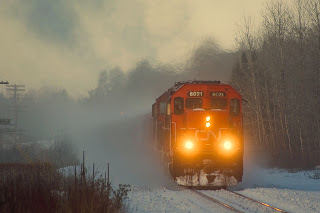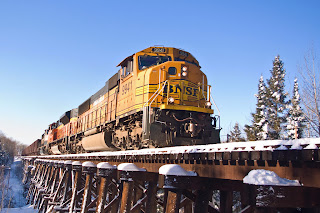(NOTE: as a rookie fireman, there are very possibly mistakes in the following. Please be patient and let me know about any errors so they can be corrected. Thanks, Jim)
Seems like a good title for a post discussing the life and times of a greenhorn steam engine crew member. Many of you are likely aware of the fact that I've recently been inducted into the steam locomotive brotherhood, having done a couple of turns on the SOO 2719 as she hauls passengers from the Duluth Depot up to Two Harbors and back.
What's it like to spend time in and around an operating steam locomotive? There are quite a few words that partially describe the situation-some that come to mind include hot, dirty, exciting, exhausting (in more ways than one), confusing, stimulating, educational-where can I stop? Oh, I can't leave out nerve-wracking. All in all it's an information overload if you've never done it before.
For someone whose pre-conceived notion of steam locomotive operation could be described as "show up, make sure it's full of water, and shovel like a madman", it took just a few minutes to learn how wrong I was. The details of shaking the grates, raking the fire, shaking again, dumping ash, and raking some more (and more, and more, to get those chunks and clinkers broken up)...
And those things came after removing the exhaust cap and blowdown plugs. Remember, we still haven't tossed a single scoop of coal or started any appliances on the locomotive. Any movement is only due to the assistance of a diesel. Finally, we are set off at the track where we can take water and begin the process of bringing the old girl to life.
A comment here-something I've observed about steam locomotives. In my very limited experience, an operating steamer is not so much a machine as it is a living being. Like a living being, it requires food (coal) and water. For the most part, just as in interpersonal relationships, the fruits of the interaction will be directly proportional to the effort you are willing to put in. Neglect her needs, and there will be consequences, and in rare cases those consequences could be severe. On the other hand, paying close attention to non-verbal cues can give you good input on what she expects of you. I suspect no two are exactly alike, and even the most familiar locomotive can surprise you from time to time.
In many ways, dealing with a steam locomotive is like dealing with a woman. Treat her right, and she will return the favor.
Back to the day's preparations. With a sprinkling of coal on the grates, ignited by the remnants of the previous day's fire, we have begun the process of building steam for today's journey. Now remember, it's crucial that someone monitor the sight glasses and try-cocks in the cab to ensure that the boiler water is kept at a safe level. Occasionally, we're required to inject water into the boiler. If you happen to be walking past the engineer's side of the cab when the injector is activated, be ready for a bath as water rushes out of the drainline under the cab. Keep in mind that it may well take two or three tries to get the injector working. Don't forget that with the throttle closed, you will need to run the blower at a low speed to maintain some draft through the firebox and provide combustion air for the coal you continue to sprinkle in a thin, even layer across the grates. If the tender isn't full of coal, this will also be a good time to climb up and shovel a few tons forward for easy access during the coming trip. And don't forget to monitor the water level in the tender if you are filling it, lest you encounter this:

And never forget to monitor the fire you are establishing.
But you still aren't ready to go. There are more inspections to complete, and more appliances to prepare for service. We won't be going anywhere without compressed air, so it's about time to open the drain cocks on the air pump, give the lubricator 50 turns, and SLOWLY open the steam valve to start the pump. Be sure there is plenty of oil in the pump before starting!
Speaking of oil, we don't want the oil in the pilot truck bearings contaminated with water, so someone will have to crawl under the locomotive and drain each of the four bearings to remove any accumulated water.
With any luck the guy doing this job won't drop one of the plugs. If he does, it makes more work. And on the subject of bearings, be sure to check the journals on the tender.
During this process, be sure to keep an eye open for anything unusual as you walk around the loco-missing cotter keys or pins, loose nuts or bolts, or any of the other myriad of fasteners and components that together create a machine. Only an experienced eye can take in the entirety of the machine and detect that one abnormality that may lead to trouble down the road.
As the dynamo comes on-line with the opening of the steam valve feeding it, watch a light to ensure it doesn't burn too bright. Now is the time to detect and fix problems.
With boiler pressure nearing 200 psi and the air pump thunk-thunking its rhythmic song, we are getting very close to ready to go. After a final check of the locomotive, it may be a good time to fortify yourself with a donut before the time to move arrives. This is also the time when a rookie fireman may get instructed in some of the finer points of feeding a boiler, a task which is not made any easier if said rookie happens to want to shovel left-handed. A few glances at the fire, and guidance on a firing pattern, and with a shovel in your hand you make the first tentative attempts at feeding the 2719. I'm not positive, but I think they do this to make you forget what firing will be like with the locomotive underway. It's hard enough standing still, the degree of difficulty goes up with each MPH added to the speedometer as the engine sways back and forth on the rails.
Then, in a great cloud of steam, water, and coal smoke, the time comes to back away from the servicing area. An experienced fireman feeds the firebox a "round" as the engineer backs down the 6/7 lead to the switch, then takes her ahead to run around the train. With boarding and departure fast approaching, we need to have time to pump up the air system on the train, do a brake test, and board passengers. Also there is no way we are leaving without a cooler chock full of water and gatorade on ice for the engine crew.
Now you have been introduced to the process of preparing to leave. Next time, some discussion of what it's like out on the road. Hope you enjoy!














































